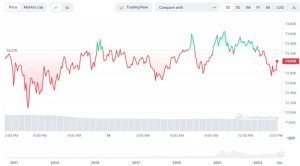Bitcoin’s (BTC) price in the last 24 hours has experienced a downturn, shedding about 0.25% to trade at $72,973 after surpassing the $73,000 milestone and touching an all-time high of $73,800.
This reversal comes amidst growing concerns about the sustainability of the recent rally, with analysts cautioning about a potential cool-off period for the cryptocurrency. On the last day, the BTC price swayed between an intra-day low and high of $71,720.18 and $73,750.07, respectively.

BTC/USD 24-hour price chart (source: CoinMarketCap)
During the dip, BTC’s market capitalization and 24-hour trading volume dipped by 0.20% and 30.28%, respectively, to $1,435,010,021,694 and $44,459,611,460. This slight drop in price could be attributed to profit-taking by investors who bought in at lower prices, as well as general market uncertainty surrounding the bullish rally.
Analyst Warnings Signal Cooling Phase
Analysts at Swissblock have highlighted a negative divergence between Bitcoin’s price trajectory and the Relative Strength Index (RSI) momentum indicator on the 4-hour chart. This bearish signal suggests that while Bitcoin’s price has been climbing, the momentum behind the rally is dwindling.
• 📉 Bitcoin’s Price Momentum Waning: Swissblock analysts note a negative divergence between Bitcoin’s price and the RSI momentum indicator, suggesting a possible price drop.
The Relative Strength Index (RSI) is a momentum indicator used in technical analysis that measures the…
— Pushpendra Singh Digital (@PushpendraTech) March 14, 2024
As a result, Swissblock forecasts a possible 20% decline in Bitcoin’s price, with the cryptocurrency potentially dropping to the $58,000-$59,000 range in the near future. Despite this anticipated pullback, analysts emphasize that this would likely be a temporary setback, with the overall uptrend expected to resume eventually.
Matrixport, another crypto investment services firm, echoes similar sentiments, noting that Bitcoin’s rally is showing signs of waning momentum. The declining RSI in conjunction with high Bitcoin prices, indicates a need for consolidation in the market. Matrixport analysts suggest that while the bull market still has momentum, Bitcoin may need to undergo a period of consolidation before resuming its upward trajectory.
Volatility in the Cryptocurrency Market
The sudden dip in Bitcoin’s price was part of a broader burst of volatility across the cryptocurrency market. Altcoins such as Ether (ETH), Ripple (XRP), and Litecoin (LTC) experienced significant declines. However, Avalanche’s native token (AVAX) stood out as a notable gainer, recording an increase for the day.
The heightened volatility, consequently, led to over $360 million worth of leveraged derivatives positions being liquidated across all cryptocurrencies, primarily affecting long positions betting on rising prices. This liquidation event marked the largest flush-out of long positions since the March 5 correction, underscoring the inherent risks associated with leveraged trading in the crypto market.
Market Reaction to Inflation Data
The volatility in the cryptocurrency market coincided with the release of U.S. inflation data, which came in hotter than expected for February. The Consumer Price Index (CPI) rose by 3.2%, slightly surpassing analyst expectations. This uptick in inflation raised concerns about the Federal Reserve’s monetary policy stance, as sticky inflation could deter the central bank from implementing interest rate cuts.
NOW – U.S. reports “hotter than expected” inflation data.
disclosetv pic.twitter.com/kkU8TilNJp
— Jack Straw (@JackStr42679640) March 13, 2024
However, Aurelie Barthere, principal research analyst at Nansen.ai, downplayed the significance of the inflation reading on the crypto market. Barthere emphasized that the bullish momentum in crypto is likely to overshadow short-term economic indicators like inflation. While the inflation data may prompt a reassessment of expected Fed rate cuts, Barthere anticipates that any repricing would not trigger a significant sell-off in crypto assets, given the prevailing bullish sentiment.


